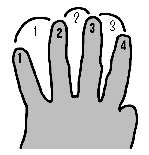Another View: 3-Act Progressions
Some two thousand years ago, Aristotle proposed that every plot should have a beginning, a middle, and an end. Since then, this notion has evolved into a widely held view there should be three Acts in a complete story. Act one sets up the dramatic potentials. Act two plays these potentials against one another. Act three describes how it all turned out.
At first, a three-act progression might seem in conflict with Dramatica's four act view. As we shall see, however, the two naturally go together.

The illustration above shows how a plot that covers four different Acts will automatically produce three different transitions as the subject matter shifts from one concern to the next. In a sense, we might think of a throughline's plot as a road.

At the beginning of the road is the point of departure, City A. At the end of the road is the destination, City D. Along the way are two other cities, B and C. The first leg of the journey begins at City A and ends at City B. The second leg begins at B and ends at C. The final journey begins at City C and ends at the destination, City D.
At each city is a Signpost that gives its name. The four signposts in a throughline's plot are the names of the Types. The order in which they will occur in the plot controls where they fall along the road. Between the four signposts are three Journeys, each of which describes traveling from one signpost to the next.
Returning to an earlier example, Signposts A, B, C, and D might be Learning, Understanding, Doing, and Obtaining. The Three journeys in this plot would then be Learning-->Understanding, Understanding-->Doing, and Doing-->Obtaining. With four signposts and three journeys, each throughline's plot has seven different Progressive Story Points required for that perspective to be complete.
When Aristotle saw a beginning, middle and end, he was seeing Signpost A, all three journeys lumped together, and Signpost D. When successive generations of writers evolved a three-act structure, it became difficult to figure out, "What happens in Act 2?" All three journeys and two of the signposts blended into "the middle". By adopting a Four-Act structure that coincides with three dynamic acts, the true nature of a throughline's plot is far easier to understand and construct.
